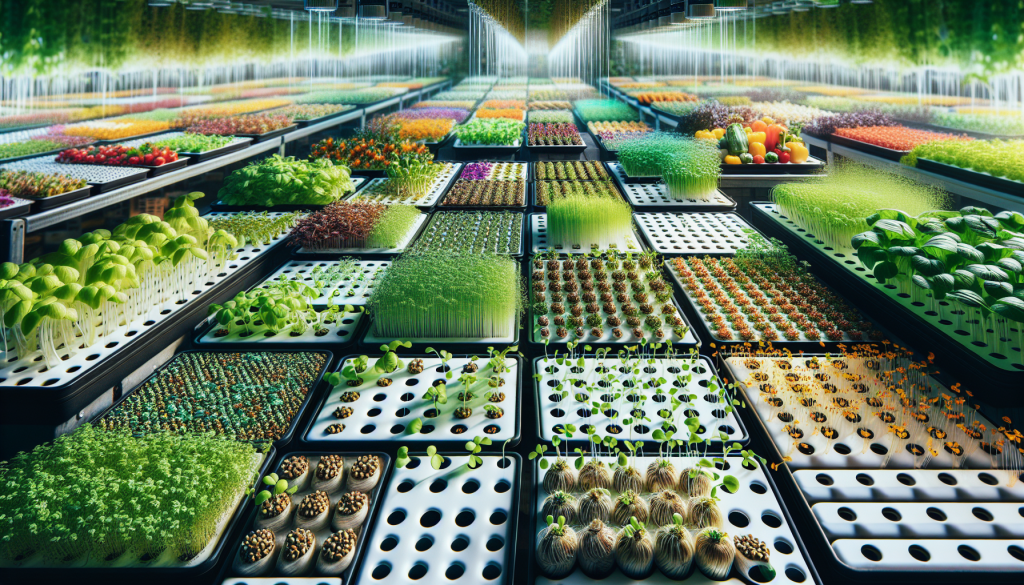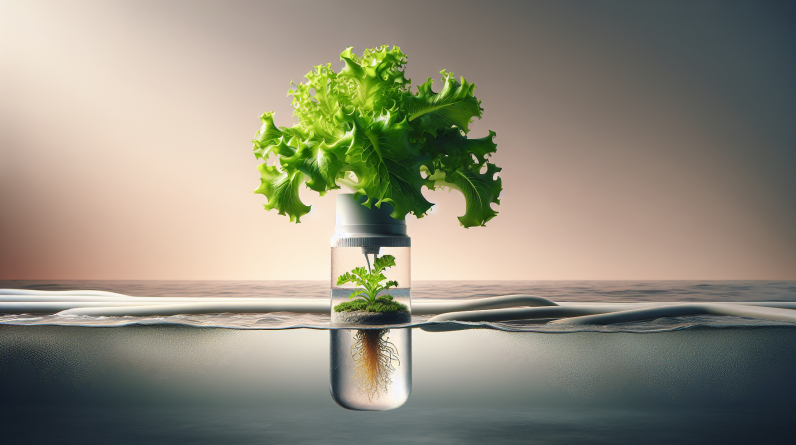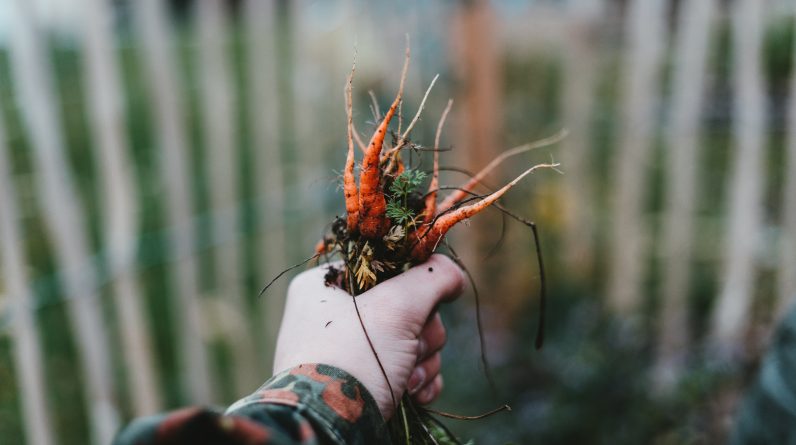
Imagine a world where you can grow plants without the need for soil. A world where you can cultivate a beautiful garden in the confines of your own home, using only water and nutrients. This is the world of hydroponics, a method of growing plants that is gaining popularity among garden enthusiasts. But what kind of seeds can you use in hydroponics? In this article, we will explore the different types of seeds that thrive in this unique growing environment, providing you with the knowledge you need to start your own hydroponic garden. Get ready to discover a new way to grow your favorite plants, all from the comfort of your home.
Leafy Greens
Lettuce
Lettuce is one of the most commonly grown leafy greens in hydroponics. It is known for its crisp texture and mild flavor. There are various types of lettuce, including romaine, butterhead, and iceberg. Each variety has its own unique characteristics and growing requirements. Lettuce seeds are readily available and can easily be sown in a hydroponic system.
Spinach
Spinach is another popular leafy green that can be successfully grown in hydroponics. It is rich in nutrients such as iron, vitamin C, and vitamin K. Spinach seeds are small and can be directly sown in a hydroponic system. This versatile green can be enjoyed in salads, smoothies, or cooked dishes.
Kale
Kale has gained immense popularity for its high nutritional content and health benefits. It is known for its sturdy leaves and slightly bitter taste. Kale can be grown from seeds in a hydroponic setup and provides a constant supply of fresh greens. Its vibrant green color and unique texture make it a visually appealing addition to any dish.
Swiss chard
Swiss chard is a leafy green that belongs to the beet family. It has large, dark green leaves and colorful stems in shades of red, yellow, and white. Swiss chard seeds can be easily germinated in a hydroponic system. It is known for its earthy flavor and can be used in various recipes, such as sautés, salads, and soups.
Arugula
Arugula, also known as rocket, is a peppery-flavored leafy green that adds a tangy kick to any dish. It has distinctive lobed leaves and a strong flavor profile. Arugula seeds can be grown in a hydroponic system, providing a constant supply of fresh greens for salads, sandwiches, and pesto sauces. Its bold taste and nutritional content make it a popular choice among health-conscious individuals.
Herbs
Basil
Basil is a versatile herb that is widely used in various cuisines around the world. It is known for its sweet aroma and strong flavor. Basil seeds can be easily germinated in a hydroponic system, allowing you to have a constant supply of fresh basil leaves. This herb is perfect for adding a burst of flavor to pasta dishes, salads, and even homemade pesto.
Cilantro
Cilantro, also known as coriander, is a herb commonly used in Mexican, Indian, and Asian cuisines. It has a distinctive aroma and a citrusy, slightly peppery taste. Cilantro seeds can be grown hydroponically, providing a consistent source of this flavorful herb. It can be used as a garnish, added to salsas, or incorporated into marinades and dressings.
Mint
Mint is a fragrant herb that adds a refreshing taste to both sweet and savory dishes. It is commonly used in cocktails, teas, salads, and desserts. Mint seeds can be easily grown in a hydroponic system, ensuring a fresh supply of leaves throughout the year. Its cooling properties make it a popular choice for soothing stomach discomfort and adding a burst of flavor to dishes.
Parsley
Parsley is a versatile herb that is often used as a garnish or added to salads, soups, and sauces. It has a mild, slightly peppery taste and is rich in vitamins A, C, and K. Parsley seeds can be germinated in a hydroponic setup, providing a continuous harvest of this flavorful herb. Its vibrant green leaves and delicate texture make it an attractive addition to any dish.
Dill
Dill is a herb with feathery green leaves and a unique flavor profile that is often described as tangy and slightly sweet. It is commonly used in pickling, seafood dishes, soups, and sauces. Dill seeds can be easily grown hydroponically, allowing you to have a constant supply of fresh dill year-round. Its aromatic qualities and distinct taste make it a popular choice for enhancing the flavor of various dishes.

This image is property of images.unsplash.com.
Microgreens
Broccoli
Broccoli microgreens are packed with nutrients and have a milder, more delicate flavor than mature broccoli. These tiny seedlings are easy to grow in a hydroponic system and can be harvested within a couple of weeks. Broccoli microgreens are commonly used in salads, sandwiches, and as a garnish. They not only add visual appeal to dishes but also provide a concentrated dose of vitamins and minerals.
Radish
Radish microgreens have a peppery taste and vibrant colors that add a burst of flavor and visual appeal to any dish. They are quick to grow and can be harvested in just a few weeks. Radish microgreens are commonly used in salads, sandwiches, and stir-fries. They are known for their high levels of vitamin C and other essential nutrients, making them a nutritious addition to your hydroponic garden.
Kale
Kale microgreens are packed with nutrients and have a milder taste compared to fully grown kale. They are known for their vibrant green color and delicate texture. Kale microgreens are easy to grow hydroponically and can be harvested within a couple of weeks. They can be added to salads, wraps, sandwiches, or used as a flavorful garnish.
Mustard
Mustard microgreens have a spicy and tangy flavor that adds a kick to any dish. They have vibrant green leaves with a hint of red or purple. Mustard microgreens are quick to grow in a hydroponic system and can be harvested within a couple of weeks. They are commonly used in salads, sandwiches, and as a garnish. Mustard microgreens are rich in vitamins A, C, and K, as well as antioxidants.
Sunflower
Sunflower microgreens have a mild nutty flavor that pairs well with a variety of dishes. They have a distinct appearance with long stems and small leafy greens. Sunflower microgreens are easy to grow hydroponically and can be harvested within a couple of weeks. They are commonly used in salads, wraps, sandwiches, and as a topping for soups and stir-fries. Sunflower microgreens are rich in vitamins, minerals, and healthy fats.
Fruiting Vegetables
Tomatoes
Tomatoes are one of the most popular fruits to grow hydroponically. They come in a variety of sizes, colors, and flavors, making them a versatile choice for any hydroponic gardener. Tomato seeds can be easily germinated in a hydroponic system, and with the right care, you can enjoy a bountiful harvest of fresh tomatoes throughout the year. From cherry tomatoes to beefsteak tomatoes, the options are endless.
Cucumbers
Cucumbers are a refreshing and hydrating fruit that can thrive in a hydroponic environment. They come in various shapes, sizes, and colors, with each variety having its own unique flavor profile. Cucumber seeds can be easily germinated in a hydroponic system, providing a consistent supply of fresh cucumbers for salads, pickling, and snacking. Their crisp texture and mild flavor make them a favorite among gardeners.
Bell peppers
Bell peppers are a colorful addition to any hydroponic garden. They come in a variety of vibrant colors, including green, red, yellow, and orange. Bell pepper seeds can be germinated in a hydroponic system, producing sweet and crunchy peppers that can be enjoyed raw, roasted, or added to various dishes. The different colors of bell peppers indicate different levels of ripeness and sweetness.
Eggplants
Eggplants, also known as aubergines, are a versatile vegetable that can be grown hydroponically. They come in various shapes, sizes, and colors, ranging from small round varieties to long slender ones. Eggplant seeds can be easily germinated in a hydroponic system, providing a consistent supply of this nutritious vegetable. Eggplants can be grilled, roasted, sautéed, or used in casseroles and stews.
Strawberries
Strawberries are a delicious and nutritious fruit that can be grown hydroponically. They are known for their sweet and juicy flavor, as well as their vibrant red color. Strawberry plants can be easily grown from seeds in a hydroponic system, allowing you to enjoy fresh strawberries year-round. The compact size of hydroponic strawberry plants makes them suitable for smaller spaces or vertical gardening setups.
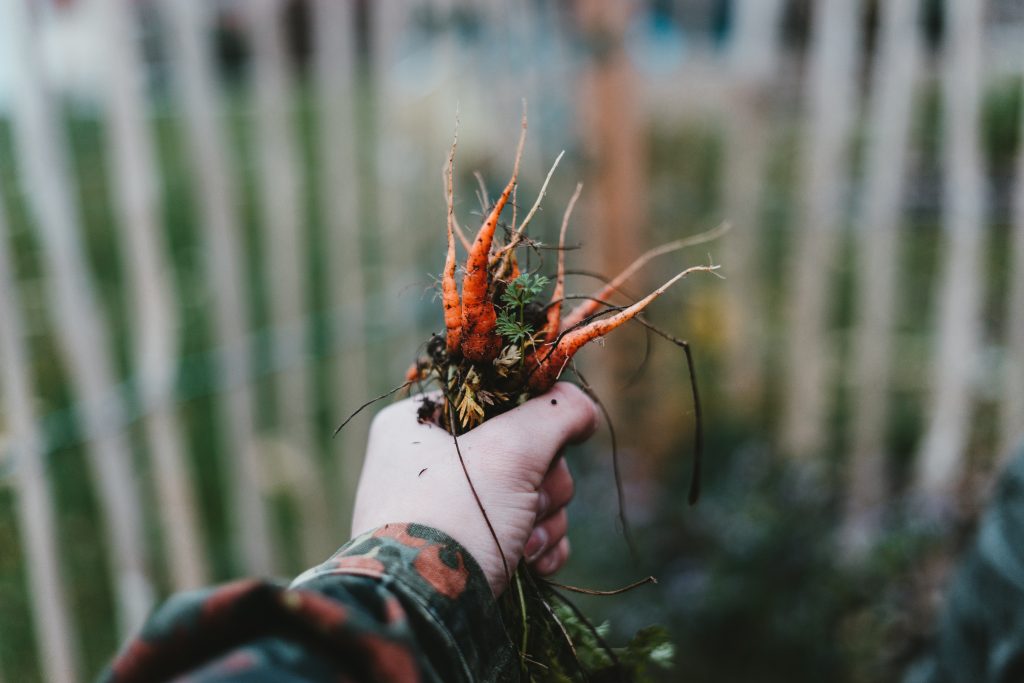
This image is property of images.unsplash.com.
Root Vegetables
Carrots
Carrots are a popular root vegetable that can be grown hydroponically. They come in various colors, including orange, purple, yellow, and white. Carrot seeds can be germinated in a hydroponic system, providing a continuous supply of fresh and crunchy carrots. Hydroponic carrots are known for their sweeter flavor and tender texture. They can be enjoyed raw, steamed, roasted, or used in soups and stews.
Beets
Beets are a nutritious root vegetable that can be grown hydroponically. They come in various colors, including red, yellow, and striped varieties. Beet seeds can be easily germinated in a hydroponic system, producing vibrant and flavorful beets. The leaves of the beet plant, known as beet greens, can also be harvested and used in salads or cooked dishes. Beets are rich in vitamins, minerals, and antioxidants.
Radishes
Radishes are a fast-growing root vegetable that can be easily grown hydroponically. They come in various shapes, sizes, and colors, from small round radishes to long and slender ones. Radish seeds can be germinated in a hydroponic system, providing a continuous supply of these crunchy and peppery vegetables. Radishes are commonly used in salads, sandwiches, and garnishes, adding a burst of flavor and color.
Turnips
Turnips are a versatile root vegetable that can be grown hydroponically. They have a mild and slightly sweet flavor, with both the roots and leaves being edible. Turnip seeds can be easily germinated in a hydroponic system, producing crisp and flavorful turnips. The leaves can be harvested and used in salads or cooked dishes. Turnips are rich in vitamins, minerals, and fiber, making them a nutritious addition to your hydroponic garden.
Scallions
Scallions, also known as green onions or spring onions, are a popular addition to various dishes. They have a mild flavor and are commonly used as a garnish or added to stir-fries, salads, and soups. Scallion seeds can be germinated in a hydroponic system, providing a continuous supply of fresh scallions. The green tops of scallions can be harvested, while the white bulb can be left to regrow for future harvests.
Legumes
Peas
Peas are a versatile legume that can be grown hydroponically. They come in various types, including garden peas, snow peas, and sugar snap peas. Pea seeds can be easily germinated in a hydroponic system, providing a steady supply of fresh peas. Pea plants can either be grown with support or as a climbing vine. Fresh peas can be enjoyed raw, steamed, stir-fried, or added to salads, soups, and pasta dishes.
Beans
Beans are a nutritious and protein-rich legume that can be grown hydroponically. They come in various types, including green beans, pole beans, and bush beans. Bean seeds can be easily germinated in a hydroponic system, producing tender and flavorful beans. Beans can be enjoyed raw, steamed, stir-fried, or used in salads, soups, stews, and casseroles. They are a versatile addition to any hydroponic garden.
Lentils
Lentils are a protein-packed legume that can be grown hydroponically. They come in various colors, including green, brown, red, and black. Lentil seeds can be easily germinated in a hydroponic system, providing a continuous supply of these nutritious legumes. Lentils can be cooked and used in a variety of dishes, including soups, stews, curries, salads, and side dishes. They are known for their earthy flavor and hearty texture.
Chickpeas
Chickpeas, also known as garbanzo beans, are a versatile legume that can be grown hydroponically. They are commonly used in various cuisines around the world, including Indian, Middle Eastern, and Mediterranean dishes. Chickpea seeds can be germinated in a hydroponic system, providing a consistent supply of these protein-rich legumes. Chickpeas can be cooked and used in salads, hummus, curries, stews, and roasted snacks.
Soybeans
Soybeans are a nutritious legume that can be grown hydroponically. They are known for their high protein content and are commonly used in various forms, including tofu, soy milk, tempeh, and edamame. Soybean seeds can be easily germinated in a hydroponic system, providing a constant supply of fresh soybeans. They can be cooked and incorporated into a wide range of dishes, adding a plant-based protein source to your diet.

This image is property of images.unsplash.com.
Cruciferous Vegetables
Cabbage
Cabbage is a cruciferous vegetable that can be grown hydroponically. It comes in various colors, including green, red, and savoy varieties. Cabbage seeds can be easily germinated in a hydroponic system, producing crunchy and flavorful heads of cabbage. Cabbage can be enjoyed raw, cooked, or used in slaws, stir-fries, soups, and fermented dishes like sauerkraut. It is known for its high levels of vitamin C, fiber, and antioxidants.
Cauliflower
Cauliflower is a versatile cruciferous vegetable that can be grown hydroponically. It comes in various colors, including white, purple, and orange varieties. Cauliflower seeds can be germinated in a hydroponic system, producing tender and flavorful heads of cauliflower. Cauliflower can be enjoyed raw, roasted, steamed, or used in stir-fries, soups, and mashed cauliflower dishes. It is low in calories and rich in vitamins, minerals, and antioxidants.
Broccoli
Broccoli is a nutritious cruciferous vegetable that can be grown hydroponically. It is known for its vibrant green color and distinctive shape. Broccoli seeds can be easily germinated in a hydroponic system, providing a continuous supply of this nutrient-dense vegetable. Broccoli can be enjoyed raw, steamed, roasted, or added to salads, stir-fries, soups, and pasta dishes. It is rich in vitamins A, C, and K, as well as fiber and antioxidants.
Brussels sprouts
Brussels sprouts are a compact cruciferous vegetable that can be grown hydroponically. They are known for their distinctive shape and slightly bitter taste. Brussels sprout seeds can be germinated in a hydroponic system, producing small and flavorful sprouts. Brussels sprouts can be roasted, sautéed, grilled, or used in stir-fries and salads. They are packed with vitamins, minerals, fiber, and antioxidants.
Kohlrabi
Kohlrabi is a unique cruciferous vegetable that can be grown hydroponically. It has a bulbous shape with a crisp texture and mild flavor. Kohlrabi seeds can be easily germinated in a hydroponic system, providing a continuous supply of this versatile vegetable. Kohlrabi can be enjoyed raw, roasted, steamed, or used in salads, slaws, stir-fries, and soups. It is rich in vitamins, minerals, and fiber, making it a nutritious addition to your hydroponic garden.
Sprouts
Alfalfa
Alfalfa sprouts are tender and mild-tasting sprouts that can be easily grown hydroponically. They are commonly used in salads, sandwiches, wraps, and stir-fries. Alfalfa seeds can be sprouted in a hydroponic system, providing a continuous supply of these nutritious sprouts. Alfalfa sprouts are rich in vitamins, minerals, and antioxidants, making them a healthy addition to your hydroponic garden.
Bean
Bean sprouts, such as mung bean sprouts or soybean sprouts, are commonly used in Asian cuisines. They have a crisp texture and subtle nutty flavor. Bean seeds can be sprouted in a hydroponic system, providing a steady supply of these crunchy sprouts. Bean sprouts are commonly used in stir-fries, salads, soups, and spring rolls. They are rich in protein, fiber, vitamins, and minerals.
Clover
Clover sprouts are delicate and mild-tasting sprouts that can be grown hydroponically. They have a slightly sweet and grassy flavor. Clover seeds can be sprouted in a hydroponic system, providing a consistent supply of these nutritious sprouts. Clover sprouts are commonly used in salads, sandwiches, and as a garnish. They are rich in vitamins, minerals, and antioxidants.
Radish
Radish sprouts have a peppery taste and vibrant colors, adding a burst of flavor and visual appeal to any dish. They are quick to grow and can be easily sprouted in a hydroponic system. Radish sprouts are commonly used in salads, sandwiches, and stir-fries. They are known for their high levels of vitamin C and other essential nutrients, making them a nutritious addition to your hydroponic garden.
Sunflower
Sunflower sprouts have a mild nutty flavor that pairs well with a variety of dishes. They have a distinct appearance with long stems and small leafy greens. Sunflower seeds can be sprouted in a hydroponic system, providing a continuous supply of these nutritious sprouts. Sunflower sprouts are commonly used in salads, wraps, sandwiches, and as a topping for soups and stir-fries. They are rich in vitamins, minerals, and healthy fats.
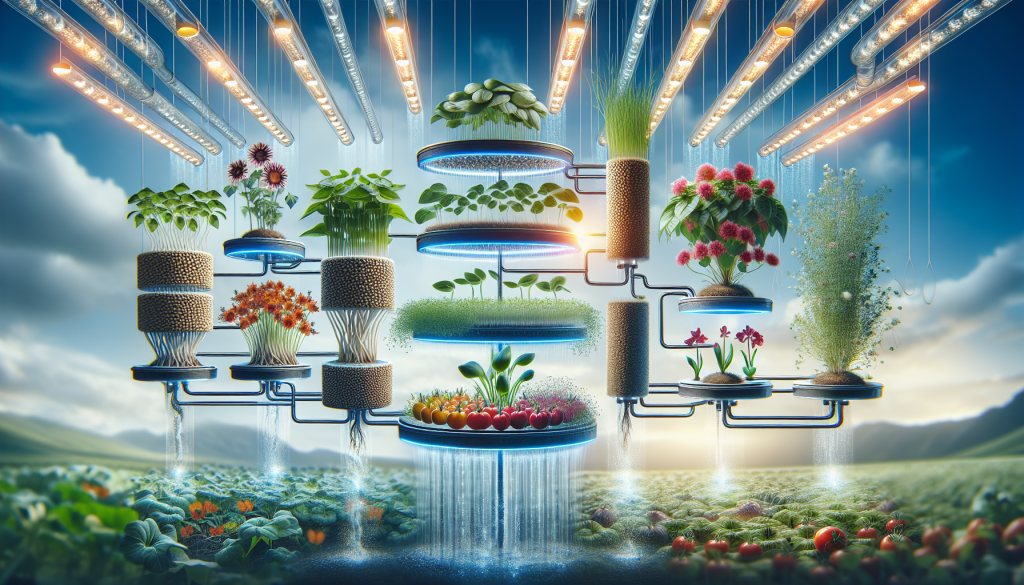
Edible Flowers
Nasturtium
Nasturtium flowers are not only beautiful but also edible. They come in vibrant colors, including red, orange, and yellow. Nasturtium seeds can be easily germinated in a hydroponic system, producing these edible flowers. Nasturtium flowers have a slightly peppery flavor and can be used to garnish salads, soups, and desserts. They are also often pickled and used in various culinary creations.
Calendula
Calendula flowers, also known as pot marigold, have bright orange and yellow petals. They are known for their vibrant color and slightly spicy flavor. Calendula seeds can be easily germinated in a hydroponic system, producing these edible flowers. Calendula flowers can be used to garnish salads, soups, and desserts. They are also often dried and used to make herbal teas or infused oils.
Pansy
Pansy flowers are delicate and come in a variety of colors, including purple, yellow, and white. They have a slightly sweet and floral taste. Pansy seeds can be germinated in a hydroponic system, producing these edible flowers. Pansy flowers can be used to add a pop of color to salads, desserts, and beverages. They are often used in culinary creations for their decorative appeal.
Borage
Borage flowers are vibrant blue and have a mild cucumber-like flavor. They are known for their star-like shape and attractive appearance. Borage seeds can be easily germinated in a hydroponic system, producing these edible flowers. Borage flowers can be used to garnish salads, cocktails, and desserts. They are also popularly used in herbal teas and infused oils.
Chive blossoms
Chive blossoms are the flowering part of chive plants. They have a delicate purple color and a mild onion flavor. Chive seeds can be germinated in a hydroponic system, producing these edible flowers. Chive blossoms can be used to garnish salads, soups, and creamy dishes. They are often used as a flavorful and decorative element in various culinary dishes.
Fruit Seeds
Watermelon
Watermelon seeds are a nutritious and edible part of the fruit. They are commonly roasted and consumed as a snack or used in various recipes. Watermelon seeds can be easily germinated in a hydroponic system, producing vines that bear juicy and sweet watermelons. Watermelon flesh, along with its seeds, can be enjoyed fresh, blended into smoothies, or used in salads and desserts.
Cantaloupe
Cantaloupe seeds are edible and can be easily germinated in a hydroponic system. Cantaloupe plants produce sweet and juicy melons that are a favorite among many. The flesh of the cantaloupe, along with its seeds, can be enjoyed fresh, blended into smoothies, or used in salads and desserts. Cantaloupes are known for their refreshing flavor and are a popular summer fruit.
Honeydew
Honeydew seeds can be germinated in a hydroponic system, producing vines that bear sweet and juicy honeydew melons. The flesh of the honeydew melon, along with its seeds, can be enjoyed fresh, blended into smoothies, or used in salads and desserts. Honeydew melons have a mild and refreshing flavor, making them a popular choice for fruit salads and summer treats.
Pumpkin
Pumpkin seeds, also known as pepitas, are edible and can be easily germinated in a hydroponic system. Pumpkins are a type of winter squash that are known for their bright orange flesh. The flesh of the pumpkin, along with its seeds, can be used in a variety of recipes, including soups, stews, pies, and baked goods. Pumpkin seeds can be roasted and enjoyed as a healthy snack or used as a topping for salads, granola, and desserts.
Squash
Squash seeds are edible and can be easily germinated in a hydroponic system. There are various types of squash, including zucchini, butternut squash, and acorn squash. The flesh of squash, along with its seeds, can be enjoyed in a variety of savory dishes, such as roasted vegetables, soups, stir-fries, and casseroles. Squash seeds can also be roasted and enjoyed as a nutritious snack or used in granola and trail mixes.
In conclusion, there is a wide variety of seeds that can be successfully grown in a hydroponic system. From leafy greens and herbs to microgreens, fruiting vegetables, root vegetables, legumes, cruciferous vegetables, sprouts, edible flowers, and fruit seeds, the possibilities are endless. Growing your own hydroponic garden allows you to have a constant supply of fresh and nutritious produce regardless of space limitations or climate conditions. Whether you’re a seasoned gardener or a beginner, hydroponics offers a convenient and sustainable way to grow a wide range of plants and satisfy your culinary needs. So grab your seeds, set up a hydroponic system, and enjoy a bountiful harvest of homegrown goodness!
